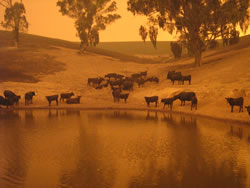
Cattle, sheep and other agricultural stock are your livelihood and need protection from bushfires.
Managing livestock during a bushfire can be challenging, especially when large areas of your farm are burning. There are steps you can take to make your livestock as safe as you can during bushfires, and it all starts with your farm plan.
Plan ahead
Prepare an emergency plan that covers major disasters ahead of the fire season and communicate it to everyone on your farm. Your plan should include:
- which animals you intend to evacuate and which you will leave behind,
- it should identify evacuation routes, vehicles and destinations,
- ensure your property has a Property Identification Code (PIC) registered with Agriculture Victoria that indicates livestock are present. If your property is impacted by fire Agriculture Victoria may be able to enter after the fire to check on the welfare of your livestock,
- ensure your National Livestock Identification System (NLIS) tags and microchip details are all current.
Create a 'safe' paddock
Create a place you can move your livestock to and provide a better chance of them surviving. As 'safe' paddock is one that:
- is large enough for livestock to move freely,
- is easy to access and well fenced,
- has adequate water supply without relying on electric pumps,
- is kept green or grazed hard to reduce the fuel load, and
- is not surrounded by thick vegetation, trees, long grass or haystacks.
Create a containment area for after a fire
A containment area should be created on a carefully selected part of the property that is set up to hold, feed and water your core livestock after a fire.
The area should be maintained and available during emergencies.
If your property isn't safe for your livestock you might want to consider agisting them out of the area during summer or moving them on EXTREME or CATASTROPHIC fire danger days.
Activate your plan before fire threatens
Act quickly to move your livestock to your designated 'safe' paddock or another safe place well before the fire reaches your property.
Moving stock after a fire has started is dangerous. You will find yourself driving through thick smoke, encounter fallen trees and powerlines and face the threat of collisions or being trapped by fire. The safer option is to leave early and protect yourself and your animals.
For livestock you intend to evacuate, move them early in the day or shift them to the safe paddock. Animals should be clearly identified in case you're separated.
For the animals remaining on your property, move them to your low risk area. Move stock early in the day as some can be scared by the smoke and heat.
- Fill water troughs.
- Put out enough feed to last five days.
- Do not cut fences alongside roads because loose livestock can cause accidents - a bad outcome for both road users and your livestock.
After a fire
If your animals are injured seek veterinary attention immediately.
If your livestock is lost notify your local council, microchip registry, neighbours and local animal shelters. Social media can be a good source of information about lost or found animals and to find emergency feed, water, agistment and other helpful resources.
hide
Resources:
Page last updated: Tuesday, 1 October 2024 4:57:35 PM